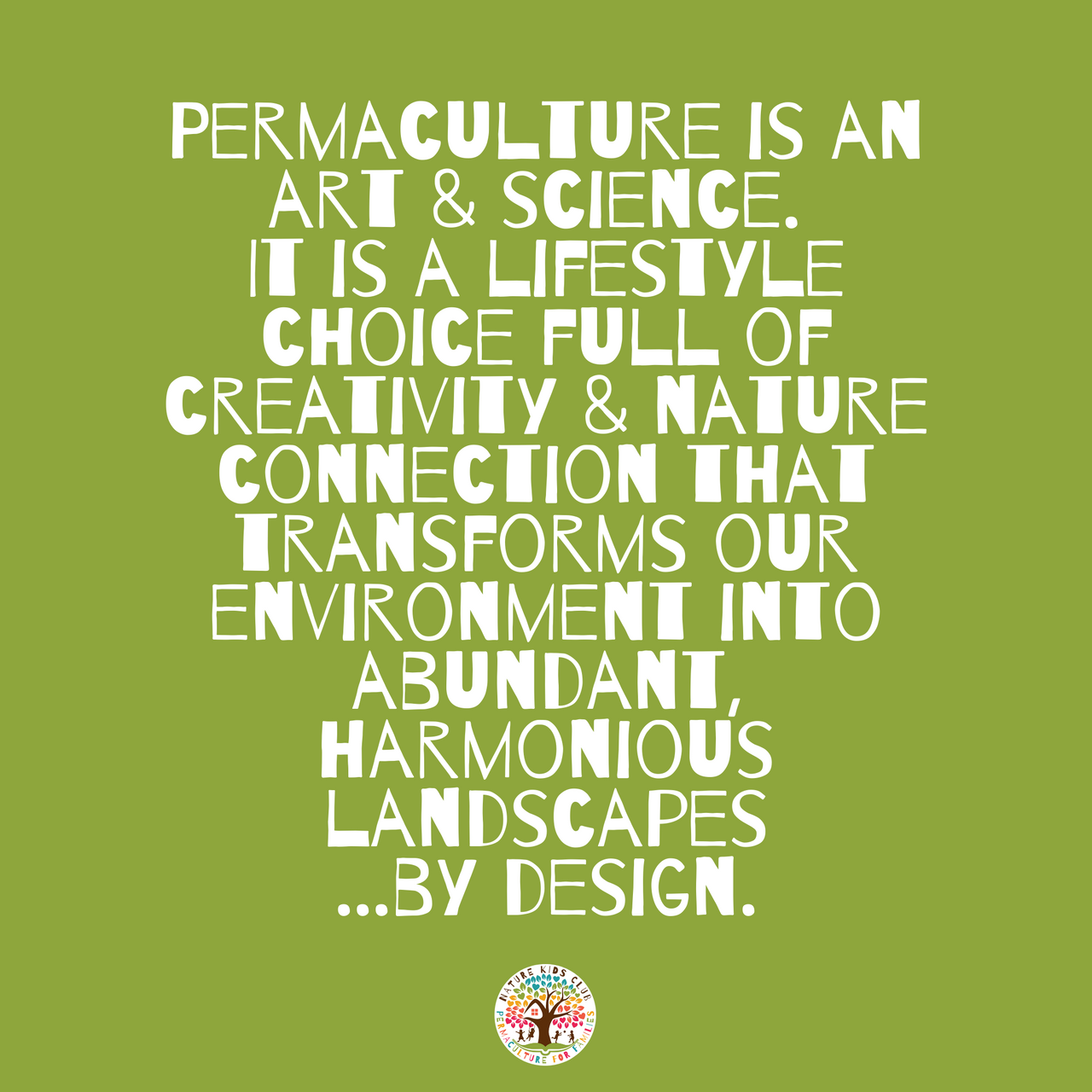What is Permaculture?
Dec 17, 2020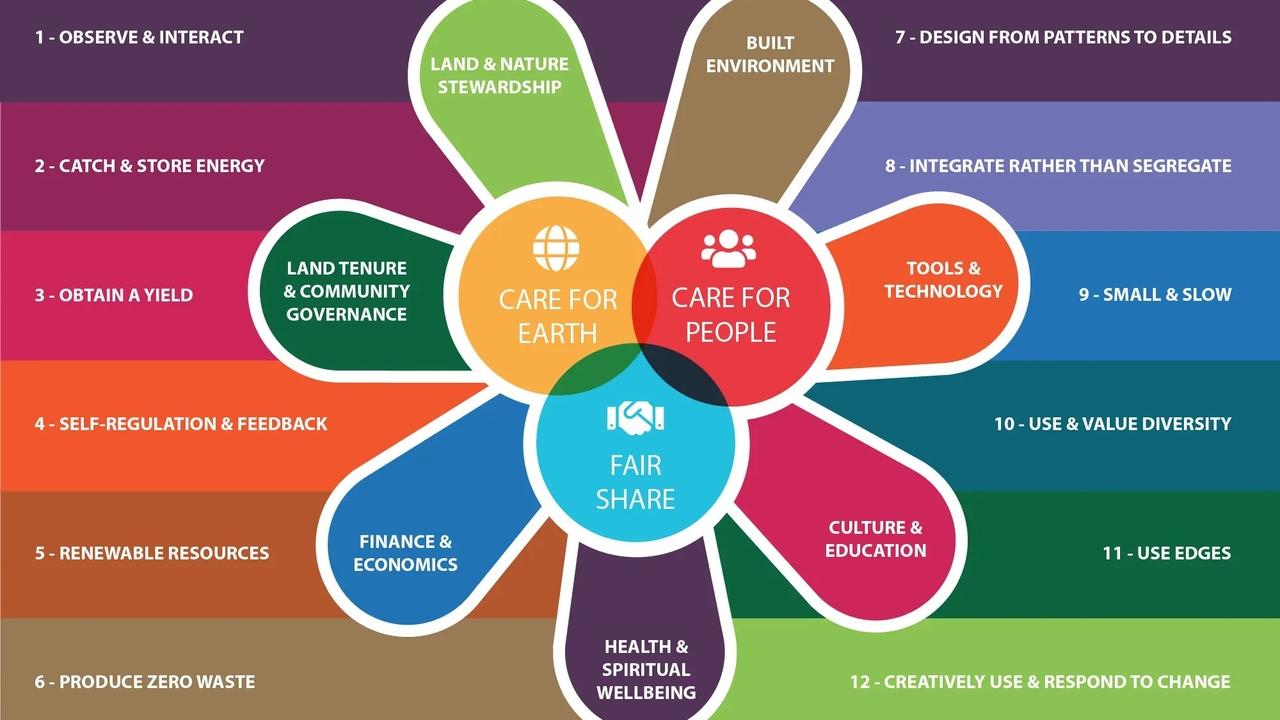
I have been teaching Permaculture to groups and 1:1 for over a decade and never cease to be amazed when I witness people learn that it is much more encompassing than growing your own food. That was my initial thought and reason for attending my first course too!
This blog offers a short and long answer to the question of '"What is Permaculture" to give some clarity and some additional insight into the permaculture flower, which illustrates and refers to the different domains of life. This introduction often expands people's awareness of how we use design to improve our lifestyles and influence the social realms that require change.
Here goes...
The short answer is; Permaculture is an ethical design system for living sustainably on Earth.
Beyond this one-liner, it is holistic design philosophy, with ethics and principles rooted in ecological science, which combines the art and science of working with nature to provide for the needs of humans whilst regenerating the earth.
My personal favourite is: Permaculture is an art and science. It is a lifestyle full of creativity and nature connection that transforms our environment into abundant, harmonious landscapes by design.
I like this explanation because it speaks to the outcome of producing an abundant landscape by design, a combination of both a creative process to illustrate a plan alongside our understanding of ecology and how to read nature's patterns - so that our design harmonises and regenerates. The lifestyle aspect really speaks to 'living permaculture', becoming an earth carer and someone who constantly connects with nature and has the mindset and physical tools to transform.
It is the ethics/values and principles which help guide us with decision-making. Think of them as the strategies that form our creative process and live a sustainable lifestyle.
As a designer, we learn this skill set. The good news is that anyone can learn it...as humans of the earth, it's embedded in our cells. Children pick it up easily, and when we begin the journey of putting our 'permie goggles' on, we begin remembering...a lens through which the world makes sense.
Below is an example of an artistic landscape illustration that works with nature...the energy flows of the sun, water, earth and wind. Produced by Blake Hudson, the EarthEartisan who provides this professional service. We live our permaculture life together!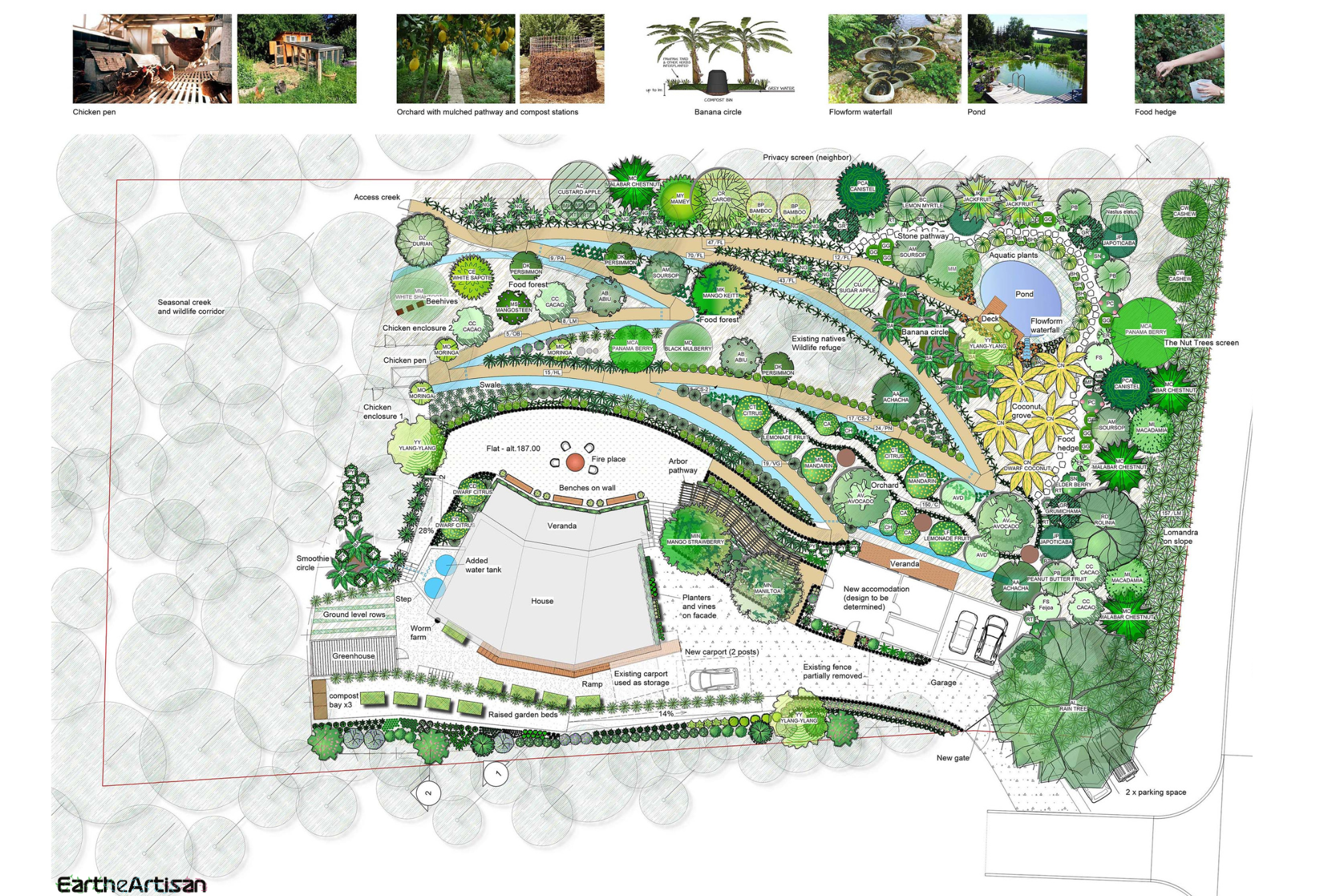
Let's go deeper...
Permaculture was originally coined by Bill Mollison and David Holmgren in the mid-1970s
PERM(anent)(agri)CULTURE combines these two words, coined by Bill Mollison and David Holmgren, both a lecturer and an earth sciences student. To describe an integrated, evolving system of perennial or self-perpetuating plant and animal species useful to man.
They aimed to integrate the separation of the different sciences so that hydrology, geology, ecology and sociology could be applied meaningfully to solve land degradation issues.
It is the study of nature and whole systems thinking and engages and influences many people. Since its conception in Tasmania in the 1970s, it has become a global grassroots movement to build a sustainable culture in response to the pressing issues of destruction and control of the earth's resources and inequality.
Permaculture focuses on people, their buildings and how they organise themselves, creating community ecosystems where plants, animals, humans and all forms of ecological diversity can interact and thrive.
Beyond the obvious sustainable food production, it also incorporates business, government, economics, group processes, social systems and inner work (individual).
On a personal level, it results in a lifestyle of integrating ecologically sustainable qualities into our lives and communities.
As mentioned, Permaculture has a focus on using ecological ethics and principles as tools to consciously design landscapes that mimic the relationships and patterns found in nature, aiming to establish systems to provide an abundance of food, fibre, medicine, water, shelter, energy and therefore health, in a way that does not destroy the natural ecosystems of the earth.
Ethics of Permaculture
• Care of Earth • Care of People • Share the Surplus + an additional Spirit Care ethic has been adopted by some.
The image below is an informative and colour-in resource from the Nature Kids Permaculture Program For Families, which deepens into the meaning of each Ethic in more detail.
 Principles of Permaculture
Principles of Permaculture
David Holmgren has articulated these 12 principles as listed below. Each has an icon and a proverb to help understand this concept or philosophy. We like to take it further in our program to 'live' or engage with the principles in practical ways so that they can be embodied for head, heart and hands-on learning. You can even sing and dance to them with the musical lyrics by Charlie Mgee (featured at the bottom of this blog). 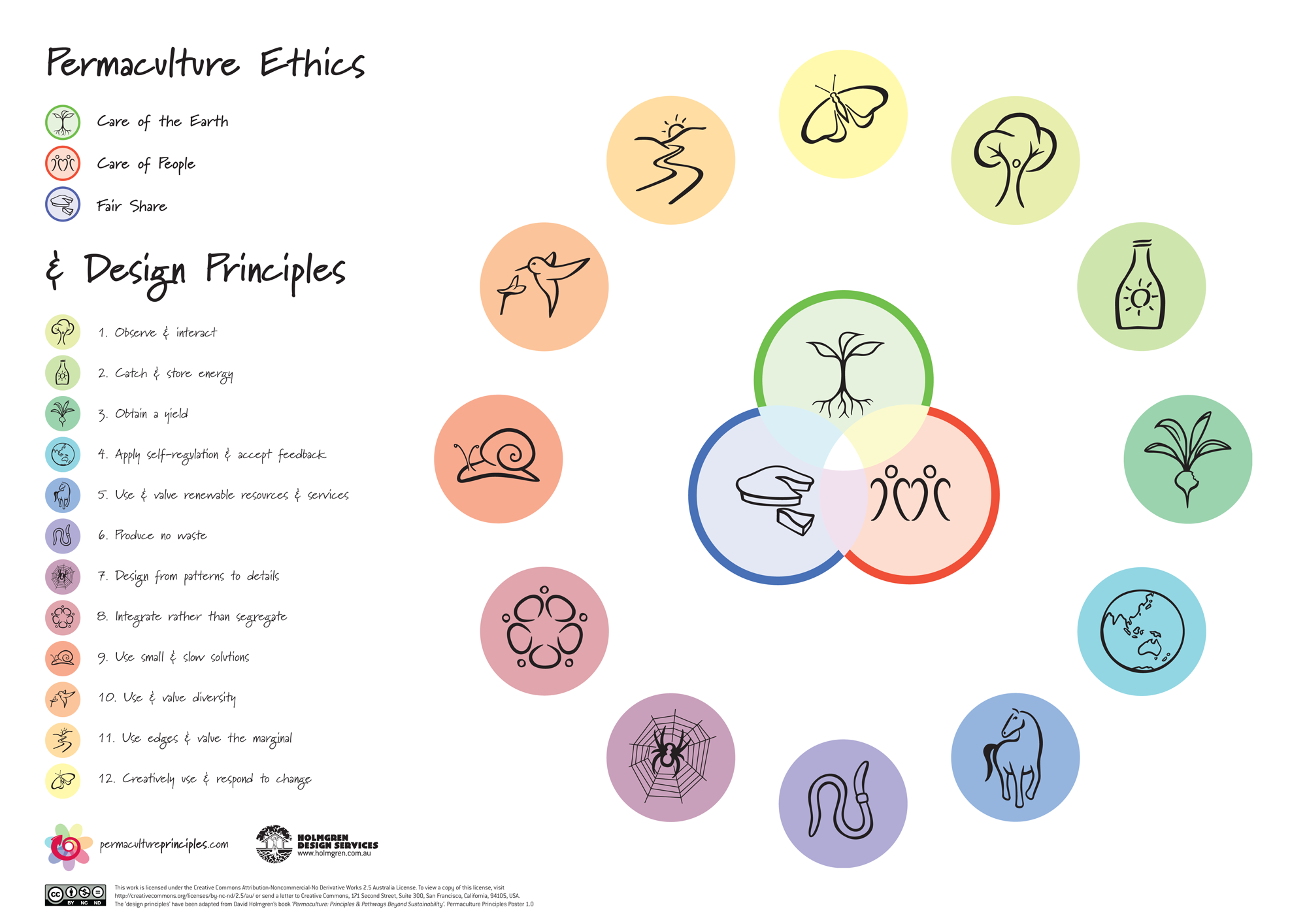
Here is a basic overview:
-
Observe and interact: We can design solutions that suit our particular situation by engaging with nature. “Beauty is in the eye of the beholder”.
-
Catch and store energy: By developing systems that collect resources when they are abundant, we can use them in times of need. “Make while the sun shines.”
-
Obtain a Yield: Ensure you get truly useful rewards for your effort. “You can’t work on an empty stomach”.
- Apply Self-regulation and Accept Feedback: We must discourage inappropriate activity to ensure that systems can continue functioning well. Negative feedback is often slow to emerge. “The sins of the father are visited on the children"
- Use & Value Renewable Resources and Services: Make the best use of nature’s abundance to reduce our consumption and dependence on non-renewable resources. “Let nature takes its course”.
- Produce No Waste: By valuing and using all the available resources, nothing goes to waste. “A stitch in time saves nine. Waste not want not”.
- Design From Pattern to Details: We can observe patterns in nature and society by stepping back.
These can form the backbone of our designs, with the details filled in as we go. “Can’t see the forest for the trees.” - Integrate Rather Than Segregate: By putting the right things in the right place, relationships
develop between them, and they work together to support each other. “Many hands make light work”. - Use Small and Slow Solutions: Small and slow systems are easier to maintain than big ones,
using local resources better and producing more sustainable outcomes. “The bigger they are, the harder they fall. Slow and steady wins the race:” - Use and Value Diversity: Diversity reduces vulnerability to various threats and takes advantage of the unique nature of the environment in which it resides. “Don’t put all your eggs in one basket”.
- Use Edges and Value The Marginal: The interface between things is where the most
interesting events occur. These are often the system's most valuable, diverse and productive elements. “Don’t think you are on the right track just because it is a well-beaten path”. - Creatively Use and Respond To Change: We can positively impact inevitable change by carefully observing and intervening at the right time. “Vision is not seeing things as they are but as they will be”.
For more information and free downloads for thinking tools for an era of change, click on the image below.
The Permaculture Domains and Flower...
You've been introduced to the Ethics and Principles, which can be applied on any scale or climate worldwide. Now, let's zoom out to the big picture with the Domains illustrated here as the Permaculture Flower. The spiral represents the application of the ethics and principles at the core, to be practised and lived by ourselves, at home, and outwards by designing and influencing our families, workplaces, community and beyond.  The main domains are:
The main domains are:
- Land and nature stewardship
- Land Tenure and Community Governance
- Tools and technology
- Building
- Education and Culture
- Finances and economics
- Health and spiritual wellbeing
This means we can take the ethics and principles and apply them to each of the Domains to solve problems and re-design outdated systems towards a sustainable outcome.
The image below illustrates how the Domains can be influenced similarly to the flower above. The (T) is the technique that is likely to be different in response to the scale.
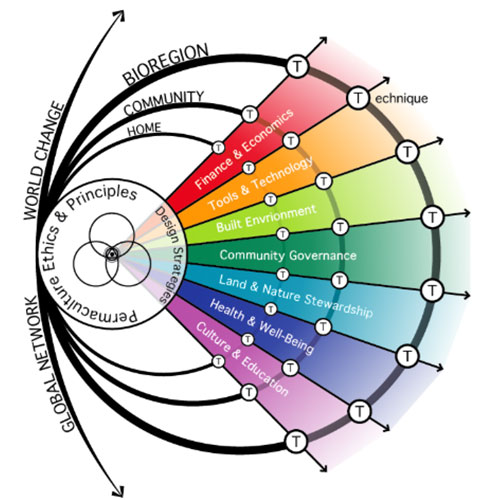
For e.g. The principle of Produce No Waste regarding Food might be applied by techniques (T) such as;
Home: Home composting systems, including worm farms and hot compost.
Community: Drop off locations to community gardens or local market gardens to compost larger quantities and produce food for those same people.
Bioregion: Council pick up of food waste bins and large-scale recycling with initiatives like 'City to Soil' to improve farmland with compost materials produced.
When guided by the permaculture principles and ethics as decision-making tools and strategies, we can take action as individuals, influencing sustainable practices starting at Home, engaging Community, supporting our Bioregion and influencing beyond. By progressively integrating all the domains mentioned, we can develop networks of locally appropriate solutions of localised techniques (T) and be far better equipped to thrive in the uncertain future.
Some Goals of Permaculture...
Grow food where people are • Re-forest the Earth • Reclaim and build soil • Sequester carbon to balance the biosphere • Create a regenerative culture • Catalyse a global grassroots movement for Ecological, Social, and Cultural Healing • Restorative justice • Education for self-reliance • Connect with nature • Right livelihoods.
Learn About Permaculture Through Music...
Have you heard of the Formidable Vegetable Sound System?
Through his lyrics, Charlie Mgee has done a superb job of singing and bringing the permaculture principles to your subconscious to soak up this juicy knowledge in the most entertaining and extremely fun way...you can't help but shake it and be inspired...unless you don't like music!
Interested? Click here to view his album. A Rhymer's Manual is a practical wake-up call to action covering the 12 permaculture principles on a ukulele so you can turnip the radish beets!
“Formidable Vegetable Sound System is spearheading a new and exciting form of musical activism and becoming one of the most important voices in a global cultural movement that began right here in Australia.” - Harry Angus, The Cat Empire
Watch this Youtube clip for a sneak peek of what to expect, Yield - Formidable Vegetable (Official Permaculture Music Video)
Begin Your Permaculture Journey...
I call it a journey because when you step on the path of permaculture, the learning never ends... it becomes a way of life and, more specifically, a healthy, empowered lifestyle, with ongoing aha moments, sites to see and vistas to connect to...and a destination I imagine as being composted in the earth with a tree planted over.
On this journey, though, there is a great community of plant-loving folk and fellow earth carers to walk alongside. You'll be swept up by those with land stewardship visions, creatives and problem-solving whole-system thinkers...who know how to enjoy epic feasts from their gardens.
I am so passionate about this way of life and go into much more depth in my online courses and group retreats, so please contact me if you are keen to learn more!
Otherwise, tune into my Podcast to hear more and journey alongside me and the other incredible permaculturalists I interview about all things Permaculture and Herbalism. Listen here: The Elder Tree Podcast.
